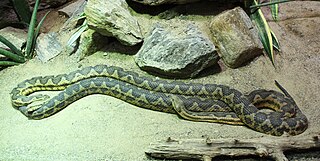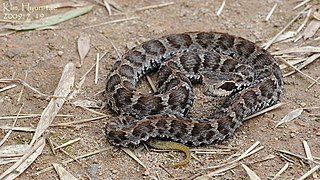The Crotalinae, commonly known as pit vipers, or pit adders, are a subfamily of vipers found in Eurasia and the Americas. Like all other vipers, they are venomous. They are distinguished by the presence of a heat-sensing pit organ located between the eye and the nostril on both sides of the head. Currently, 23 genera and 155 species are recognized: These are also the only viperids found in the Americas. The groups of snakes represented here include rattlesnakes, lanceheads, and Asian pit vipers. The type genus for this subfamily is Crotalus, of which the type species is the timber rattlesnake, C. horridus.

Echis coloratus, known as the painted saw-scaled viper, painted carpet viper, Burton's carpet viper, and by other common names, is a highly venomous viper species endemic to the Middle East and Egypt. No subspecies are currently recognized.

Gloydius is a genus of venomous pitvipers endemic to Asia, also known as Asian moccasins or Asian ground pit vipers. Named after American herpetologist Howard K. Gloyd, this genus is very similar to the North American genus Agkistrodon. 24 species are currently recognized.

Gloydius himalayanus also known as the Himalayan pit viper or the Himalayan viper is a venomous pitviper species found along the southern slopes of the Himalayas in Pakistan, India and Nepal. No subspecies are currently recognized. Himalayan pit vipers have been found up to 4900m above sea level, which makes it the highest living snake ever found.

Gloydius blomhoffii, commonly known as the mamushi, Japanese moccasin, Japanese pit viper, Qichun snake, Salmusa or Japanese mamushi, is a venomous pit viper species found in Japan. It was once considered to have 4 subspecies, but it is now considered monotypic.

The many-horned adder is a viper species. It is found in certain rocky desert areas, mostly along the Atlantic coast of southern Africa, in western South Africa and southwestern Namibia. It has characteristic tufts of "horns" above each eye. Like all other vipers, it is venomous. No subspecies are currently recognized.

The Moorish viper is a venomous viper species found in northwestern Africa. No subspecies are currently recognized.

Montivipera raddei, also known as the Armenian viper and by many other common names, is a species of venomous snake in the subfamily Viperinae of the family Viperidae. The species is endemic to Armenia, Azerbaijan, Iran, Turkey, and possibly also Iraq. Two subspecies are currently recognized.

Gloydius halys is a venomous pitviper species found within a wide range that stretches across Asia, from Russia, east of the Urals, eastwards through China. Five subspecies are currently recognized, including the nominotypical form described here.

Trimeresurus flavomaculatus is a venomous pit viper species endemic to the Philippines. Two subspecies are currently recognized, including the nominate subspecies described here.
Crotalus lorenzoensis is a species of pit viper.
Mixcoatlus barbouri is a venomous pit viper species endemic to Mexico. No subspecies are currently recognized.

Ovophis okinavensis, commonly known as the hime habu (ヒメハブ), Ryukyu Island pit viper, and the Okinawan pitviper, is a venomous pitviper species found in the Ryukyu Islands of Japan. No subspecies are currently recognized.

Craspedocephalus borneensis, commonly known as the Bornean pit viper, is a venomous pit viper species endemic to the island of Borneo. No subspecies are currently recognized.

Gloydius intermedius, or Central Asian pit viper, is a venomous species of pitviper endemic to northern Asia. Three subspecies are currently recognized, including the nominate subspecies described here.
Gloydius monticola is a venomous pitviper species endemic to southern China. A small and darkly colored snake with no visible color pattern, it is found high in the mountains of northern Yunnan province. No subspecies are currently recognized.
Gloydius shedaoensis is a venomous pitviper species found only on Shedao Island in China. Although very small, this island is home to an extraordinarily large population of these snakes. No subspecies are currently recognized.
Gloydius strauchi is a species of venomous pit viper in the subfamily Crotalinae of the family Viperidae. The species is native to western China. It is a small snake with a pattern of four longitudinal stripes, although some older specimens may be a uniform black. G. strauchi may be distinguished from G. monticola by its higher midbody dorsal scale count. This species jointly holds the altitude record for pitvipers together with Crotalus triseriatus of Mexico, both being found even above the tree line at over 4,000 m (13,000 ft). No subspecies were recognized as being valid, until a recent publication re-evaluated the taxonomic statuses of populations of G. strauchi and described the eastern Tibetan populations as a new species.

Gloydius ussuriensis is a venomous pitviper species endemic to far east Russia, northeastern China and the Korean Peninsula. No subspecies are currently recognized.

Gloydius brevicauda is a venomous pitviper species endemic to China and the Korean Peninsula.














